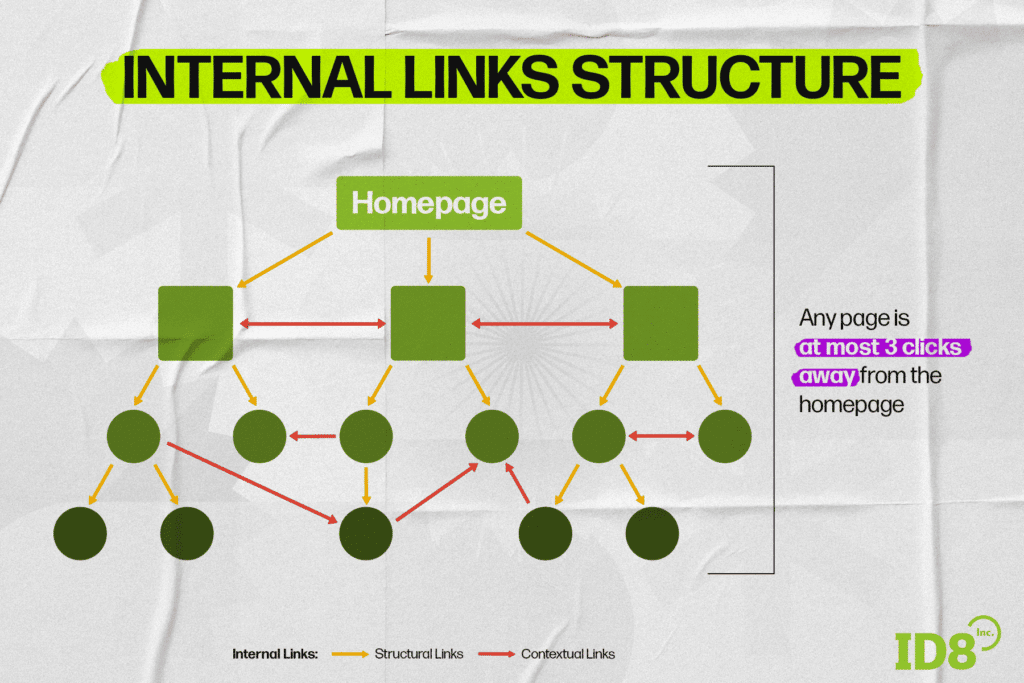The Role of Internal Linking in SEO: Strategies and Best Practices
When it comes to search engine optimization (SEO), most businesses focus on keywords, backlinks, or content creation. While those are vital, there’s one often overlooked tactic that can dramatically improve your rankings, engagement, and conversions: internal linking. At ID8 SEO Services, we’ve seen how a strong internal linking strategy can transform a website’s visibility, strengthen authority, and make the user journey seamless.
This post explores what internal linking is, why it matters, and the strategies and SEO best practices you can use to maximize its impact.
What is Internal Linking?
Internal linking is the practice of connecting one page on your website to another within the same domain. These links guide both users and search engine crawlers to related content, creating a logical pathway through your site.
Unlike external links, which point visitors to other websites, internal links keep users engaged with your content, encourage deeper exploration, and signal to search engines how your site is structured. Done correctly, internal linking helps build relationships between pages, establishes hierarchy, and passes authority (often called link equity) to your most valuable content.

Why Internal Linking Matters for SEO
Internal linking isn’t just about adding clickable text—it directly supports several crucial SEO goals:
- Improved Crawlability and Indexing
Search engines use bots to crawl your website. Internal links act as pathways, making it easier for crawlers to discover and index important content. Without them, some pages risk becoming “orphaned” and invisible in search results.
- Distribution of Link Equity
When one page earns backlinks from other sites, internal links help spread that authority across your website. This boosts the ranking potential of other pages, especially new or less authoritative ones.
- Enhanced User Experience
Well-placed internal links guide visitors to related content, reducing bounce rates and keeping them engaged longer. This signals to search engines that your site provides value.
- Stronger Conversions
By strategically linking to service pages, product pages, or contact forms, you can subtly direct users toward taking action without disrupting their browsing journey.
Strategies for Effective Internal Linking
At ID8 SEO Services, we integrate internal linking into every SEO campaign we run. Here are the key strategies we recommend:
- Use Descriptive, Relevant Anchor Text
Anchor text—the clickable part of a link—should clearly describe the content of the linked page. Avoid generic phrases like “click here.” Instead, use keyword-rich, natural terms that inform both users and search engines about what they’ll find next.
- Prioritize High-Value Pages
Focus on linking to the pages that matter most—service pages, cornerstone content, high-converting blog posts, or product categories. These should receive the most internal links to maximize authority and visibility.
- Create Content Hubs or Clusters
Group related content around a central “pillar” page. This structure improves topical authority, makes your site easier to navigate, and signals to Google that your content is comprehensive.
- Deep Linking, Not Just Homepage Linking
Don’t just link everything back to your homepage. Deep linking ensures authority flows to inner pages like case studies, blog articles, or detailed service description—making them more competitive in search results.
- Keep it Natural and Balanced
Internal links should fit seamlessly within your content. Too many links can overwhelm users and dilute SEO value. As a general rule, aim for 2–5 relevant internal links per 1,000 words of content.
- Regularly Audit Your Links
Websites evolve, and so should your linking structure. Use tools like Screaming Frog, Ahrefs, or Semrush to identify broken links, outdated references, or orphan pages. A quarterly audit ensures everything stays clean and effective.
Internal Linking Best Practices Checklist
To make sure your internal linking strategy remains strong, keep these SEO best practices in mind:
- Link only to relevant and valuable pages.
- Ensure links integrate naturally into your content.
- Use Varied anchor text to avoid over-optimization.
- Keep navigation mobile-friendly to prevent misclicks.
- Update old posts with links to newer content.
- Add breadcrumb navigation for clearer site hierarchy.
How ID8 SEO Services Helps
For us at ID8 SEO Services, internal linking isn’t just an afterthought—it’s a core element of our SEO strategy. Here’s how we approach it:
- Conduct full website audits to uncover linking opportunities.
- Map out content clusters for maximum authority and relevance.
- Optimize anchor text with SEO-driven keywords.
- Implement ongoing monitoring to adjust and improve over time.
This ensures that your site is not only search-engine friendly but also easy and enjoyable for users to navigate.
Conclusion
Internal linking may seem like a small SEO tactic, but its impact is anything but minor. When done strategically, it boosts crawlability, distributes authority, enhances user experience, and drives conversion—all while strengthening your site’s overall structure.
If you want to unlock your website’s full potential, start with internal linking. And if you’d like expert guidance, ID8 SEO Services is here to help. Our tailored Strategies ensure your site not only ranks higher but also keeps visitors engaged and converting.
Final Takeaway: Internal linking isn’t optional—it’s essential. Apply the strategies and SEO best practices outlined here, and you’ll see long-term gains in both rankings and user satisfaction.
Ready to strengthen your SEO strategy with smart internal linking? Contact us today and let’s build a site that ranks and converts.



